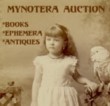|
|
|



|
|
by Craig Stark
#123, 23 June 2008
|
Unless you sell on other venues, Amazon sellers need only concern themselves with the following definition of "new":
Just like it sounds. A brand-new, unused, unread copy in perfect condition.
But suppose a book has been very carefully read, perhaps not even opened at any point to 180-degrees, and it still looks immaculate, crisp and, well, new. Can you grade it new? Unfortunately, "brand-new" necessarily means unread. If you know that a book has been read, the book isn't new and shouldn't be graded new. At best it's like new. If you don't know a book's history, you can still determine whether or not it's been read with the following test:
Place the book on its spine, holding it at 90-degrees to the surface, open the text block slightly, and let go. If the book closes, covers and all, it's new (assuming no other condition issues) - though experienced booksellers who sell on venues other than or in addition to Amazon would be more likely to use the term "Very Fine" (or, sometimes, "Fine," if a tighter scale is used).
Continuing with the same test - if the text block closes and the covers don't, we're now at "Like New" - more commonly (in the trade) "Near Fine."
Next, if the text block fans open, we're at "Very Good."
Finally, if the text block opens to 180 degrees - i.e., lies completely flat, then the grade drops to "Good."
Obviously, if other faults are present, this could affect the final grade downward, but if you perform this simple test at the outset, you'll know where your ceiling is, and you can go from there with much more assurance.
In the trade, an ex-library copy cannot rise to the level of good (though please note carefully that Amazon's system does allow sellers to grade ex-libs good if all else is fine) because in most cases they aren't collected in the true sense of the word. Part of this has to do with the presence of markings, pockets, etc., but many ex-libs have also been opened and read many times, and there's a limit to how many times this can happen before a book degrades even further - cracked or split hinges will develop, split gutters, and so on. And books that have been read countless times have a loosey-goosey feel to them that's anything but desirable. And many of them are significantly soiled.
Finally, it's important to grade a book only on the basis of its actual condition - not, for example, on the basis of its origin. In this context, a book that's purchased "new" in a Barnes & Noble or Border's may or may not in fact be new, depending on how many times it's been opened and whatever additional faults may be present.
|
|







|
|
|


